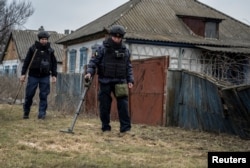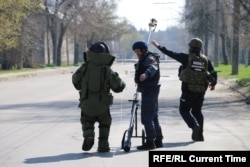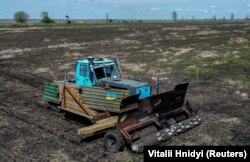As Russia masses troops near Kupyansk and shells it almost daily, Kateryna, 35, a survivor of Russia's six-month occupation of the strategic railway town in Ukraine's Kharkiv region last year, has imposed a stringent set of rules on her three children: Don't touch anything, don't step off the pavement, always ask soldiers about suspicious objects, and don't accept candy, toys, or packages from anyone -- even a neighbor.
Mines are the reason why.
The Ukrainian government estimates that mines cover roughly 30 percent -- some 174,000 square kilometers -- of Ukraine, a figure that makes it one of the most mined countries in the world. The Kharkiv region, which borders Russia and the war-ravaged Donetsk and Luhansk provinces of Ukraine, ranks among the region's worst-affected, according to the Interior Ministry's State Service for Emergency Situations (DSNS).
Since the start of Russia's full-scale invasion in February 2022, mines in the Kharkiv region have killed 27 people and wounded 195, regional government data shows. The total of 222 casualties includes 45 children.
That compares with 220 deaths and more than 450 injuries from mines nationwide, according to the DSNS.
Russia's bombardment of Kupyansk, which led to the August 10 evacuation of 12,000 area residents, means the chances of encountering land mines have now increased.
In July alone, six residents of the Kharkiv region were wounded in mine blasts. Sappers are struggling to keep pace.
As of mid-August, sappers had not managed to clear even 1 percent of the estimated 12,400 square kilometers of territory -- a third of the entire Kharkiv region -- that the government believes has been mined, according to DSNS regional spokesman Yevhen Vasylenko. Farmland, to date, has not been touched.
The DSNS and the Kharkiv military administration acknowledge that the pace of work is slow. Official blame falls on the proliferation of Russian mines as well as shortages of sappers and demining vehicles.
What sappers have cleared is primarily land around so-called critical infrastructure sites such as power lines, roads, railroad tracks, gas pipelines, and water conduits, Ivan Sokol, head of the regional department for civil defense, which coordinates all of the Kharkiv region's sappers, told RFE/RL in an interview.
Ihor Ovcharuk, head of the DSNS's Interregional Humanitarian Demining Center, which focuses on clearing civilian-inhabited territory more than 20 kilometers from the front, estimates more than 8,000 kilometers of power lines still need to be cleared.
READ: The original story in Russian by Current Time.
Ovcharuk blames traps set by the Russian armed forces for the slow cleanup of these sites.
"There's a hunt for sappers going on. The Russians are deliberately placing mines so that the sapper is blown up," he commented.
For demining vehicles to reach the affected power lines, sappers must first clear a section of road about 8 to 10 meters wide -- "the most difficult thing" in the whole operation, according to Sokol.
WATCH: A farmer whose land was on the front lines last year has taken on the risky job of mine-clearing. His former pig and cattle farm now features piles of unearthed shells and exploded mines. Bohdan, a major grower in Mykolayiv, says he couldn't wait for military sappers to clear the land -- the community urgently needs its crops and also jobs.
"The area has got extra mines," said Ovarchuk. "You start to demine one thing and another one next to it blows up."
Ovarchuk survived a mine explosion himself in May 2022. Overall, eight DSNS sappers have been killed and 33 wounded in the Kharkiv region since the start of the full-scale invasion, he told RFE/RL.
One military sapper, Major Pavlo Herman, said Russia is using its "entire arsenal" of mines, mine traps, and explosive devices against Ukraine's current counteroffensive, which began in early June and has made slow progress. Those supplies include "very developed" mines with seismic sensors that respond to movement and antipersonnel mines without a timed self-destruct device -- mines banned by the 1997 Mine Ban Treaty, of which Russia is not a signatory.
In the Zaporizhzhya region, where Herman usually works along the front line, both antipersonnel and antitank mines "totally" cover some grasslands, rather than the customary three or four rows of mines across the width of a field, he added.
"They set up mine traps that look like explosives. Or they leave a grenade under an antitank mine," Herman said. "And if an inexperienced deminer starts to remove it, then it explodes."
Summer grass as tall as two meters, which grows over dried older grass that conceals mines, further complicates matters, said Sokol.
With farmland not deemed critical infrastructure and sappers strapped for time, farmers cannot always clear out these mines without government or international funding.
In Kharkiv, Kherson, and parts of the Mykolayiv region, farmers -- many of whose operations were shut down by the war -- do not have the money to pay for demining, commented Denys Marchuk, deputy chairman of the All-Ukrainian Agrarian Council, an advocacy group. The cost for a group of professional sappers clearing an "intensively mined" field can run "from between $1,000 to $1,300 per hectare," not including surveying fees, he said.
Marchuk estimated that over 7 percent of Ukraine's farmland, roughly 28 million hectares, remains mined. So far, he said, sappers have cleared only 160,000 hectares of the 470,000 requested by the government.
In Kharkiv, to demine all of the region's mined territory within a year would require 125,000 sappers, Ovcharuk estimates. The DSNS currently only has 183.
Aside from scheduled demining, the sappers also respond to inquiries from civilians, for whom, like Kateryna's children, unusual objects can appear "interesting."
"The sappers, like the [Armed Forces of Ukraine] as well, are now worth their weight in gold," Ovcharuk told Current Time in December 2022.
Aside from the DSNS, the Special State Transportation Service, National Police, and certain armed forces units also have deployed sappers in the region. Out of 14 anti-mine groups certified to demine in Ukraine, three work in Kharkiv.
Overall, 300 people handle humanitarian demining and "operative" or urgent demining, such as when a shell is found during construction.
Vehicles are in even shorter supply. The entire region has only seven remote-controlled vehicles for mechanical demining, Sokol told RFE/RL. He believes at least 500 vehicles are needed.
He hopes a vehicle invented by Kharkiv farmer Oleksandr Krivtsov, the head of an agricultural company, can help meet that demand.
With sappers overburdened, Krivtsov, eager to sow seeds, combined a tractor with tank parts to produce his own remote-controlled demining vehicle, Reuters reported in May. In a test run, the contraption cleared 33 antipersonnel mines in a village within a few days, according to the Ukrainian public broadcaster Suspilne.
The Kharkiv region now plans to start producing the vehicle itself. Its cost is 10 times less than that of a Western model, which can cost around $1.3 million, Sokol emphasized to Suspilne.
Work on an excavator-based demining vehicle and testing of mine-detecting drones is under way elsewhere in Ukraine.
These efforts target Russian mines, but, despite being a signatory of the Mine Ban Treaty, Ukraine faces accusations from Human Rights Watch that it, too, has used antipersonnel mines that have killed and maimed Ukrainian civilians. The government has stated it will review the report.
Still, such allegations have not dented Kyiv's requests for international assistance to tackle its demining needs -- an amount that could reach $37.4 billion, according to the World Bank.
On August 13, Ukrainian President Volodymyr Zelenskiy urged Ukraine's partners to help the country respond to bolster Ukrainian security "more actively" and support local production of demining vehicles.
At the Ukraine Recovery Conference in London in June, the Croatian company DOK-ING and the Danish firm Hydrema, both manufacturers of demining vehicles, signed memoranda of understanding about collaborating with local partners to do just that.















